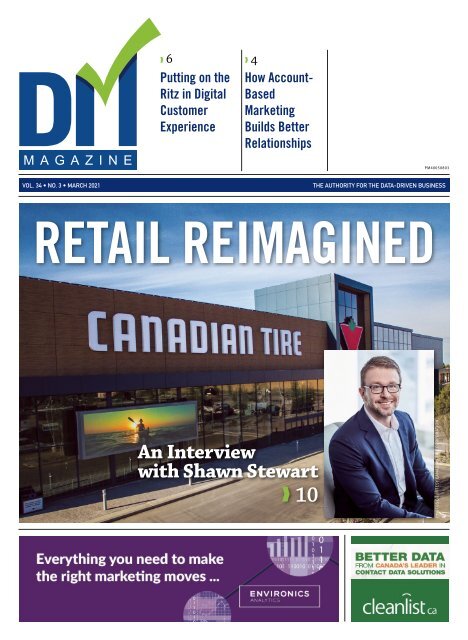DM_Mar2021
You also want an ePaper? Increase the reach of your titles
YUMPU automatically turns print PDFs into web optimized ePapers that Google loves.
❱ 6<br />
Putting on the<br />
Ritz in Digital<br />
Customer<br />
Experience<br />
❱ 4<br />
How Account-<br />
Based<br />
Marketing<br />
Builds Better<br />
Relationships<br />
PM40050803<br />
VOL. 34 • NO. 3 • MARCH 2021<br />
THE AUTHORITY FOR THE DATA-DRIVEN BUSINESS<br />
RETAIL REIMAGINED<br />
An Interview<br />
with Shawn Stewart<br />
❱ 10<br />
PHOTOS COURTESY CANADIAN TIRE CORPORATION
3<br />
ON THE COVER<br />
Vol. 34 | No. 3 | March 2021<br />
PRESIDENT<br />
Publisher & Editor-in-Chief<br />
Steve Lloyd - steve@dmn.ca<br />
DESIGN / PRODUCTION<br />
Jennifer O’Neill - jennifer@dmn.ca<br />
ADVERTISING SALES<br />
Steve Lloyd - steve@dmn.ca<br />
CONTRIBUTING WRITERS<br />
Tom Beakbane<br />
Steve Falk<br />
Christopher Daniels Deanna Ransom<br />
Bob Dowd<br />
Stephen Shaw<br />
LLOY<strong>DM</strong>EDIA INC.<br />
HEAD OFFICE / SUBSCRIPTIONS / PRODUCTION:<br />
302-137 Main Street North<br />
Markham ON L3P 1Y2<br />
Phone: 905.201.6600<br />
Fax: 905.201.6601 • Toll-free: 800.668.1838<br />
home@dmn.ca • www.dmn.ca<br />
EDITORIAL CONTACT:<br />
<strong>DM</strong> Magazine is published monthly by<br />
Lloydmedia Inc. <strong>DM</strong> Magazine may be obtained<br />
through paid subscription. Rates:<br />
Canada 1 year (12 issues $48)<br />
2 years (24 issues $70)<br />
U.S. 1 year (12 issues $60)<br />
2 years (24 issues $100)<br />
<strong>DM</strong> Magazine is an independently-produced publication<br />
not affiliated in any way with any association or organized<br />
group nor with any publication produced either in<br />
Canada or the United States. Unsolicited manuscripts<br />
are welcome. However unused manuscripts will not be<br />
returned unless accompanied by sufficient postage.<br />
Occasionally <strong>DM</strong> Magazine provides its subscriber<br />
mailing list to other companies whose product or service<br />
may be of value to readers. If you do not want to receive<br />
information this way simply send your subscriber mailing<br />
label with this notice to:<br />
Lloydmedia Inc. 302-137 Main Street North<br />
Markham ON L3P 1Y2 Canada.<br />
POSTMASTER:<br />
Please send all address changes and return all undeliverable copies to:<br />
Lloydmedia Inc.<br />
302-137 Main Street North<br />
Markham ON L3P 1Y2 Canada<br />
Canada Post Canadian Publications<br />
Mail Sales Product Agreement No. 40050803<br />
Twitter: @<strong>DM</strong>NewsCanada<br />
SALES<br />
❯❯<br />
4<br />
Nine Ways Account-Based<br />
Marketing Builds Deeper<br />
Relationships with Customers<br />
CUSTOMER EXPERIENCE<br />
INTERVIEW<br />
❯❯<br />
10<br />
Retail Reimagined<br />
An Interview with<br />
Shawn Stewart,<br />
Senior Vice President,<br />
Customer and<br />
Triangle, Canadian<br />
Tire Corporation<br />
RESEARCH<br />
❯❯<br />
8<br />
Using Customer Feedback<br />
to Beat the Competition<br />
TRANSACTIONAL DATA<br />
❯❯<br />
15<br />
Five Trends Shaping the Future<br />
of Global Payments<br />
PHOTOS COURTESY CANADIAN TIRE CORPORATION<br />
❯❯<br />
6<br />
Putting on the Ritz in Digital<br />
Customer Experience<br />
❯❯<br />
18<br />
Part 1.<br />
The Unravelling<br />
of My World<br />
MY VIEW<br />
COURTESY TOM BEAKBANE<br />
MARCH 2021 <strong>DM</strong>N.CA ❰
SALES<br />
// 4<br />
Nine Ways Account-Based<br />
Marketing Builds Deeper<br />
Relationships with Customers<br />
BY DEANNA RANSOM<br />
When customers<br />
feel heard,<br />
they begin<br />
to trust, refer a company to<br />
colleagues, friends and family, and<br />
spend more money. One-to-one<br />
customer relationships can build<br />
lifelong loyalty, but unfortunately,<br />
many of these campaigns are<br />
doomed to fail when companies do<br />
not adequately prepare.<br />
One of the most valuable ways<br />
to target and relate to customers<br />
is by implementing account-based<br />
marketing (ABM). ABM is a strategy<br />
involving the use of marketing and<br />
sales to build personalized customer<br />
relationships.<br />
ABM makes one-to-one<br />
relationships more efficient by<br />
targeting only the customers most<br />
likely to buy. By utilizing this<br />
“zero-waste” strategy, companies<br />
won’t use up valuable time or<br />
resources on mere possibilities.<br />
It’s also grounded in personalized<br />
messaging, which is essential for<br />
building brand loyalty.<br />
That’s why ABM is the integral<br />
foundation on which to build a<br />
one-to-one strategy. Here’s what<br />
marketers are saying:<br />
❯❯<br />
87 percent say ABM outperforms<br />
other marketing ventures<br />
❯❯<br />
80 percent say it increases<br />
customer lifetime<br />
❯❯<br />
86 percent say it improves win<br />
rates<br />
❯❯<br />
76 percent say it brings higher<br />
ROI<br />
Additionally, their 20 percent<br />
opportunity rate gives companies a<br />
significant leg-up on competitors.<br />
Creating deeper customer<br />
relationships that will bring higher<br />
ROI, loyalty, and efficiency—but<br />
first, companies need ABM.<br />
How to build customer<br />
relationships with ABM<br />
A one-to-one strategy combined<br />
with inbound marketing will result<br />
in the most rewarding partnership.<br />
Begin with inbound marketing to<br />
acquire a broad target market, use<br />
ABM to select specific customers<br />
within that market, and then<br />
adjust the products and services to<br />
meet the targets’ needs. Without<br />
each of the following steps, an<br />
ABM strategy will not lead to<br />
valuable customer relationships.<br />
1. Define ABM Goals<br />
The first action in any campaign is<br />
to define goals related to an ABM<br />
strategy. Some goals might include:<br />
❯❯<br />
Higher revenue<br />
❯❯<br />
Higher value from existing<br />
customers<br />
❯❯<br />
More engagement<br />
❯❯<br />
New target market segment<br />
❯❯<br />
Successful launch of a new<br />
product or service<br />
To successfully measure goals,<br />
attach KPIs to each one. With goals<br />
in mind throughout the entire<br />
campaign, mold every action<br />
thereafter to achieve the returns<br />
you want.<br />
2. Specify and Prioritize Target<br />
Market<br />
After identifying a target market<br />
from an inbound strategy, narrow<br />
the focus with ABM. Make a list of<br />
individual customers that fit the<br />
broad or “average” target market.<br />
Then select the customers that<br />
provide the most value to the<br />
organization. Those people are<br />
new “accounts” to go after—the<br />
people most worth the marketing<br />
investment.<br />
3. Build a Tech Stack<br />
ABM is built on data analysis.<br />
For any ABM campaign, tools for<br />
identifying accounts, tracking<br />
data, and measuring relationships<br />
are a must.<br />
Companies should get started<br />
with these:<br />
❯❯<br />
Data technology: Identify<br />
broad types of accounts<br />
❯❯<br />
Predictive software: Select and<br />
prioritize accounts<br />
❯❯<br />
CRM platforms: Create, manage,<br />
and track customer relationships<br />
❯❯<br />
Marketing automation and<br />
email platforms: Reach out to<br />
current customers<br />
❯❯<br />
Targeted advertising tools:<br />
Home in on the desired audience<br />
4. Align Sales and Marketing<br />
When sales and marketing don’t<br />
align, a company often will not<br />
achieve its ABM goals.<br />
While sales refers to activities<br />
that facilitate a sale, marketing<br />
refers to actions that create interest<br />
in business. Sales understands<br />
the audience but needs brand<br />
awareness; marketing can bring<br />
brand awareness but needs to<br />
understand the audience. To merge<br />
the expertise of both, encourage<br />
sales and marketing teams to<br />
collaborate on account plans.<br />
5. Talk to Customers<br />
One-to-one ABM campaigns are<br />
built on discovering customer<br />
needs. While there are many<br />
ways to do this, Jodi Harris said<br />
it best: “The best way to figure<br />
out what buyers really need is<br />
to talk to them directly.” Survey<br />
them and conduct A/B tests. Most<br />
importantly, remember to respond<br />
to the needs of a handful of<br />
high-value customers—they will<br />
appreciate the attention.<br />
6. Adjust Business to Customer Needs<br />
With every customer conversation,<br />
you’ll learn how to best serve the<br />
customer’s organizational needs<br />
and the customer’s trust in the<br />
brand will grow as. With each new<br />
piece of knowledge gained, use it<br />
to improve and personalize the<br />
product, service, or the business.<br />
7. Create Personalized, High-value<br />
Content<br />
Combining inbound marketing with<br />
ABM is powerful. On its own, quality<br />
content generates three times more<br />
leads than paid advertising and costs<br />
62 percent less, making it worth the<br />
investment.<br />
High-quality content has:<br />
❯❯<br />
A clear goal, topic, and strategy<br />
❯❯<br />
A powerful headline and hook<br />
❯❯<br />
Keyword optimization<br />
❯❯<br />
Consistent frequency<br />
Beginning with the customer<br />
in mind, create personalized<br />
content. Every blog, sales page,<br />
webinar, or newsletter should be<br />
highly relevant and valuable to the<br />
customer, creating a more positive<br />
experience and greater loyalty.<br />
8. Use Personalized Emails<br />
Email is still a powerful tool. Email<br />
generates 40 times more customers<br />
than social media, and ROI is an<br />
astounding 4,400 percent. The key<br />
to that ROI is writing emails that<br />
customers will want to open.<br />
To leave an impression and<br />
make the connection, personalize<br />
the email to customer. Try the<br />
following:<br />
❯❯<br />
Create powerful subject lines<br />
❯❯<br />
Greet the customer by name<br />
❯❯<br />
Close with a name<br />
❯❯<br />
Include relevant and appealing<br />
offers<br />
❯❯<br />
Be timely—don’t spam!<br />
❯❯<br />
Use images<br />
❯❯<br />
Offer tips for how to use<br />
company products<br />
9. Measure Results<br />
Revisit ABM goals: were revenue<br />
goals reached? How much did<br />
engagement increase? What is the<br />
conversion rate? Did the program<br />
accurately interpret customer<br />
needs, and were you able to<br />
meet them? If goals weren’t met,<br />
re-evaluate strategy.<br />
Solid customer relationships<br />
are built with ABM. Show your<br />
customers their value with a<br />
personalized approach. With<br />
these nine steps in mind, you’ll<br />
be well on your way to forging<br />
deep partnerships and building a<br />
successful ABM strategy.<br />
DEANNA RANSOM is the head of global marketing<br />
and marketing services for Televerde.<br />
❱ <strong>DM</strong>N.CA MARCH 2021
One-Stop Shop for Data-Driven<br />
Marketing Solutions<br />
Now more than ever before, it is vital to get in front of customers and prospects efficiently,<br />
economically and with customer-centricity. Melissa has been helping businesses cut waste,<br />
increase personalization and save on postage since 1985. With proven data-driven solutions,<br />
our formula for direct marketing success is as easy as 1-2-3.<br />
1. GET<br />
2. CLEAN 3. MAIL<br />
Mailing Lists &<br />
Sales Leads:<br />
Micro-target<br />
a customized<br />
list of consumer,<br />
homeowner or<br />
business prospects.<br />
Your Current<br />
Customer List:<br />
Clean up, add<br />
missing information<br />
& enrich customer<br />
marketing lists.<br />
Directly to the<br />
Mailbox or Inbox:<br />
Mail or email your<br />
list efficiently with<br />
postal presorting<br />
and email services.<br />
Get Started Today!<br />
MelissaDirect.com<br />
1-800-MELISSA
CUSTOMER EXPERIENCE<br />
// 6<br />
Ritz<br />
Putting on<br />
the<br />
in Digital<br />
Customer<br />
Experience<br />
❱ <strong>DM</strong>N.CA MARCH 2021
CUSTOMER EXPERIENCE<br />
// 7<br />
BY STEVE FALK<br />
Your driver pulls up to a beautifully<br />
lit, elegant entryway. The car door<br />
is opened by the doorman. It’s<br />
drizzling, so he opens an umbrella and leads you to the<br />
door motioning for his colleagues to gather your bags.<br />
Once inside a glowing lobby, you get smiles from the<br />
staff around you with hands outstretched guiding you<br />
to the reception desk. They offer to assist with your coat<br />
and bags. You are whisked up to your room. A welcome<br />
note and a small tray of treats awaits, “sniff, are those<br />
cookies still warm?”; the phone rings, and the voice on<br />
the line offers complimentary drinks, to be delivered<br />
along with anything else you might require. Your first<br />
impression could be compared to arriving home after<br />
school as a kid. Your mother asks about your day, a<br />
snack awaits and you are safe and at-home. And that is<br />
no accident. Studies informed the hotel industry that<br />
the comfort of a mother’s home is what, in the end,<br />
many guests desire.<br />
Staying at a great hotel is an amazing experience.<br />
They’ve had centuries to finesse their business model.<br />
The Ritz Carlton brand is synonymous with this<br />
idea of greatness. Its recent success (pandemic era<br />
notwithstanding) can be largely attributed to the datadriven<br />
guidance of Horst Shulze, their former COO<br />
and best selling author of the book Excellence Wins: A<br />
No-Nonsense Guide to Becoming the Best in a World of<br />
Compromise.<br />
The order of the day is loyalty and trust<br />
Have you had an amazing eCommerce experience<br />
lately? Is there an equivalent to the smell of warm<br />
cookies in any eCommerce or digital engagement? Who<br />
is the “Ritz Carlton” of the digital experience business?<br />
Here’s what I’m thinking. That relationships created<br />
by eCommerce transactions these days are a huge<br />
compromise and for various reasons marketers are<br />
going to have to wrestle with how to become the best<br />
in the near future. Leaders who are growing their<br />
online business must define their brand not just<br />
by making it available online, next day, same day,<br />
curbside, no charge shipping, as that’s already a given.<br />
Once everything is online, which is fast approaching,<br />
the order of the day will be loyalty and trust, in order<br />
to secure returning customers. Otherwise, your<br />
customers are just a tap, click, or swipe away from your<br />
competitor’s screen.<br />
Up to this point, the industry’s focus has been<br />
acquiring visitors and shoppers. Unlike great hotels,<br />
less attention is paid to lifetime value and retention.<br />
In my view, it’s partly due to the way investors value<br />
eCommerce business growth in this new sector. They<br />
invest in expansion of market share, user by user,<br />
assigning a value to each new customer, giving a small<br />
nod to the problem of “churn”, which is a cold way of<br />
classifying non-loyal, uninterested customers.<br />
Churn just happens. Investors just pour more money<br />
into acquisition to solve the business model. Since it<br />
can cost hundreds of dollars to acquire a new customer,<br />
what is a brand willing to spend to retain them and<br />
build loyalty? It probably should be more. Maybe a<br />
digital brand has to throw their customers a warm<br />
cookie more often instead of just leaving one in their<br />
browser?<br />
Direct mail can send from online triggers<br />
What can be learned from the hospitality industry?<br />
I’m not sure eCommerce experiences are often<br />
imagined as hospitable, with a few exceptions. Human<br />
chatbot experiences can add a personal touch, a good<br />
supporting call centre certainly improves the trust,<br />
and unboxing impressions are elevated with beautiful<br />
wrapping and hand written notes. Even well trained<br />
and personable curbside and courier staff can help to<br />
elevate the experience.<br />
Printed mail, arriving in-hand and in-home, is even<br />
in the mix as triggered direct mail can send messages<br />
within hours of online triggers, and consistently<br />
improves outcomes. Our order of kitchen spices<br />
arrived recently, and with it an aromatic experience. A<br />
personalized handwritten note and the smell of those<br />
spices as we opened the package left a remarkable and<br />
lasting impression.<br />
As a digital marketer or service provider, the more<br />
often that you provide an actual physical, sensory,<br />
in-person and in-hand experience, the longer your<br />
impact will last. I don’t have to remind you that if<br />
you show that you care, and respect the customer<br />
relationship then you will build that customer loyalty.<br />
Doing that through cold digital tactics alone, by email<br />
or SMS or banner ads, or social media, will only give a<br />
shadow of the impression of your more physical and<br />
“real” gestures. Digital experiences can be boosted and<br />
their performance amplified if they are accompanied<br />
by other physical channels. Ignore them and you’ll<br />
leave money on the table. The marketer who uses them<br />
in concert will build a trusting and loyal customer base.<br />
Horst Shulze says there are three kinds of customers.<br />
Only one is your loyal customer. The others are the<br />
“unhappy customers” that will be “terrorists against<br />
your company” on social media, and the “satisfied<br />
customers” who will simply go next door for their next<br />
purchase on a whim. But “loyal customers” are willing<br />
to pay more, increase their business with you and<br />
recommend you because they know you care for them.<br />
In that case, we all want more loyal customers.<br />
STEVE FALK is President of Prime Data. He is busy helping digital marketers<br />
exploit personalized and physical tactics which support, amplify and<br />
improve their outcomes.<br />
** A Master Class on customer service with Horst Shulze is presented at the Growth<br />
Institute https://www.scaleupu.com/horst-schulze-excellence-wins<br />
MARCH 2021<br />
<strong>DM</strong>N.CA ❰
RESEARCH<br />
// 8<br />
Using Customer Feedback<br />
to Beat the Competition<br />
BY CHRISTOPHER DANIELS<br />
Whether the<br />
business is in<br />
manufacturing,<br />
telecommunications, or software,<br />
business success relies on customer<br />
delight. When end-users are satisfied<br />
with goods or services and the<br />
support they get as part of the client<br />
experience, customers will come back<br />
again and again. Just as important,<br />
companies can use customer<br />
feedback to beat the competition<br />
and boost the bottom line.<br />
Happy customers are loyal.<br />
Recurring customers save<br />
companies money on new lead<br />
generation. Customers can also<br />
operate as a cost-efficient source of<br />
new leads, serving as inadvertent<br />
brand ambassadors if they share<br />
rave reviews with others in their<br />
network.<br />
Gathering and analyzing<br />
customer feedback to ensure<br />
end-users are content is critical<br />
to business success. Positive<br />
comments can reaffirm a company<br />
is succeeding, while negative<br />
comments can help companies<br />
identify points in need of<br />
improvement.<br />
This data can improve overall<br />
offerings, giving companies a<br />
competitive edge. Here’s how<br />
companies can make the most of it.<br />
Your No. 1 Weapon: Customer<br />
Feedback<br />
Knowledge is power, and this is<br />
especially true when it comes to<br />
meeting customers’ unique needs.<br />
With detailed feedback from realworld<br />
clientele, companies can:<br />
❯❯<br />
Monitor ongoing customer<br />
satisfaction levels.<br />
❯❯<br />
Get insights into customers’<br />
unique needs.<br />
❯❯<br />
Improve product or service<br />
offerings.<br />
❯❯<br />
Show customers care and avoid<br />
alienating them.<br />
All of this can add up to greater<br />
customer satisfaction, to more<br />
easily win over new customers—<br />
possibly even taking them from<br />
the competition. Companies<br />
can also nurture loyalty among<br />
existing clients, as satisfied<br />
consumers won’t be tempted to<br />
look to competitors for products or<br />
services.<br />
Four Ways Customer Feedback<br />
Can Help Beat the Competition<br />
Here’s how companies can use<br />
customer feedback to enhance<br />
a competitive advantage in the<br />
modern business landscape.<br />
1. Understand Customers’ Needs<br />
to Best Meet Them<br />
Keeping clients happy means<br />
understanding their wants and<br />
needs. This requires detailed and<br />
specific data. Leaders don’t simply<br />
want to know whether a customer<br />
is satisfied or not. They want to<br />
know what did and didn’t stand out<br />
in the customer journey.<br />
❱ <strong>DM</strong>N.CA MARCH 2021
RESEARCH<br />
// 9<br />
For example, consumers might<br />
be perfectly content with a product<br />
but are turned off by a negative<br />
customer service experience.<br />
Important customer success<br />
metrics could include waiting<br />
time to have an issue resolved, or<br />
versatility of support methods (e.g.,<br />
live chat, email, telephone, etc.).<br />
Many businesses are quick<br />
to assume that dissatisfied<br />
consumers mean a problem<br />
with the product or service. The<br />
issue may be a much easier fix,<br />
like tweaking an ad campaign or<br />
updating a chat bot. It’s essential<br />
to understand customers’ needs<br />
better than the competition.<br />
2. Gain Customer Insights into<br />
Employee Performance for<br />
Superior Service<br />
Customer feedback is also valuable<br />
in gaining information about<br />
employees, especially those on the<br />
front lines who deal directly with<br />
clients. For example, when offering<br />
in-house telephone support,<br />
companies should ensure that<br />
workers are dealing with callers<br />
courteously and professionally.<br />
A simple training and feedback<br />
loop for customer-facing teams<br />
can significantly impact business<br />
success. In the case of a call center,<br />
the process might involve recording<br />
calls, reviewing positives and<br />
negatives, and using data to inform<br />
coaching and future training.<br />
With this added step towards<br />
accountability, companies can<br />
improve overall customer service<br />
experience. Many consumers will<br />
switch to a different provider after<br />
a bad service experience, so this is<br />
critical to use customer feedback to<br />
beat the competition.<br />
3. Gather Competitive Intelligence<br />
to Assess Advantage<br />
Companies shouldn’t just look at<br />
customer feedback—also consider<br />
the feedback consumers are leaving<br />
competitors. Scour the internet for<br />
reviews in public forums to see how<br />
products and services compare to<br />
those of the competition.<br />
Further, companies should make<br />
sure they’re meeting the benchmark<br />
set forth by others in the same<br />
field. For example, it might seem<br />
reasonable for 80 percent of clients<br />
to be satisfied, but what if the<br />
industry standard is 95 percent?<br />
There is room for improvement in<br />
this example.<br />
Reading competitor reviews<br />
can also help identify their<br />
weaknesses. Leverage this<br />
information to pinpoint<br />
opportunities to win clients. If<br />
clients complain about a rival’s lack<br />
of telephone support, highlight<br />
this as a value-added proposition if<br />
it can be provided with confidence.<br />
4. Avoid Reputational Damage and<br />
Losing Clients to the Competition<br />
Not all customer feedback is<br />
positive. That’s normal. If a<br />
customer isn’t happy with a<br />
company, be it the product or<br />
the consumer experience, find<br />
out why. There is opportunity<br />
for improvement while avoiding<br />
similar scenarios with future<br />
consumers.<br />
Additionally, targeting negative<br />
customer feedback allows<br />
companies to fix the situation.<br />
Let’s say a person purchases a<br />
product, discovers it’s defective,<br />
and then writes a scathing<br />
complaint. There is an opportunity<br />
to remediate the issue. If they are<br />
satisfied with the response, they<br />
likely will continue to the business<br />
relationship. It’s about turning a<br />
negative into a win.<br />
Elevating the consumer<br />
experience is becoming even more<br />
critical in the wake of the COVID-<br />
19 pandemic. The most successful<br />
companies in the crisis were those<br />
that were able to identify and adapt<br />
to consumer behaviors, needs, and<br />
experiences. That kind of flexibility<br />
requires granular, real-world<br />
data—which is where customer<br />
feedback comes into play.<br />
CHRISTOPHER DANIELS is the Chief Revenue<br />
Officer for Televerde, an integrated sales and<br />
marketing technology organization based<br />
in Phoenix, Arizona. Seven of Televerde’s<br />
10 engagement centers are staffed by<br />
incarcerated women, representing 70 percent<br />
of the company’s 600+ global workforce.<br />
Foundation Magazine is the Canadian bi-monthly<br />
publication and media channel which reaches more than<br />
25,000 individual executives in Canada who represent<br />
the full charity and foundation sector and the major<br />
donor community, as well as the spectrum of companies<br />
which support, supply to, and advise all aspects of the<br />
not-for-profit industry.<br />
To advertise or to get more information and a media kit:<br />
Contact Steve Lloyd for details,<br />
steve.lloyd@lloydmedia.ca<br />
Foundation Magazine is a Lloydmedia, Inc publication.<br />
Lloydmedia also publishes <strong>DM</strong> Magazine, Total Finance magazine, Payments Business magazine, and Canadian Equipment Finance magazine.<br />
MARCH 2021<br />
<strong>DM</strong>N.CA ❰
INTERVIEW<br />
// 10<br />
PHOTOS COURTESY CANADIAN TIRE CORPORATION<br />
Retail Reimagined<br />
An Interview with Shawn Stewart,<br />
Senior Vice President, Customer and<br />
Triangle, Canadian Tire Corporation<br />
STEPHEN SHAW is the Chief Strategy Officer<br />
of Kenna, a marketing solutions provider<br />
specializing in delivering a more unified<br />
customer experience. Stephen can be reached<br />
via e-mail at sshaw@kenna.ca<br />
Traditional retailers learned a harsh lesson over<br />
this past year. Slow to make the transition to<br />
omnichannel commerce, they had misread the<br />
slow gradual rise in yearly online spending as a sign<br />
of shopper disinterest. Until the pandemic hit.<br />
The abrupt surge in online shopping left many<br />
retailers scrambling to respond. As foot traffic<br />
dropped off sharply due to restrictions on in-person<br />
shopping, they were forced to close stores. Unable to<br />
make up the difference in eCommerce sales, many<br />
retailers were pushed to the brink of insolvency.<br />
This financial carnage may have been the tipping<br />
point for the reinvention of retail. The industry has<br />
finally woken up to the fact that shopping habits have<br />
radically changed. And as product manufacturers<br />
open up their own digital storefronts, the era of retail<br />
hegemony may finally be over. Retailers will need<br />
to evolve beyond their historical role as the primary<br />
distribution channel of merchandise.<br />
In Canada one retailer has stood out above all others<br />
in transforming its business model — the century-old<br />
Canadian Tire. In the past the company has fended off<br />
incursions by U.S. giants like Walmart and Target eager<br />
to muscle in on its turf. The company’s resiliency is<br />
partly explained by its geographical footprint — most<br />
Canadians live within a 15-minute drive of a store —<br />
Shawn Stewart, Senior Vice President, Customer and Triangle,<br />
Canadian Tire Corporation.<br />
but also by its dealer network which gives the company<br />
a strong tie to each local community. In 2019 Canadian<br />
Tire was recognized as Canada’s most admired brand in<br />
Leger’s annual consumer survey. It rightfully owns the<br />
honorific “Canada’s Store”, a far cry from the days when<br />
it was mocked as “Crappy Tire”.<br />
This past year, despite all of the havoc caused by the<br />
pandemic, Canadian Tire increased comparable yearover-year<br />
store sales by 11 percent across its banners.<br />
Ecommerce sales more than doubled, an impressive<br />
feat considering the company actually backed away<br />
from online selling at one point, until it came to its<br />
senses seven years ago and began to invest heavily in<br />
its digital and eCommerce capabilities.<br />
A big part of the company’s recent success is<br />
attributable to its embrace of digital-first marketing,<br />
thanks to its 10-million-member Triangle Rewards<br />
program. Launched in 2018, Triangle Rewards is the<br />
❱ <strong>DM</strong>N.CA MARCH 2021
INTERVIEW<br />
// 11<br />
digital version of the famously<br />
popular Canadian Tire Money,<br />
once looked upon affectionately<br />
as Canada’s second national<br />
currency. The Canadian Tire<br />
Corporation (CTC) Executive in<br />
charge of loyalty and insights is<br />
Shawn Stewart who took over the<br />
role six years ago. Amongst his<br />
many accomplishments has been<br />
the stewardship of the Triangle<br />
program and the creation of an<br />
AI-driven recommendation engine<br />
which powers seven million weekly<br />
personalized offers.<br />
Stephen Shaw: Your CTC<br />
stores did amazingly well<br />
this past year in spite of the<br />
pandemic. What explains the<br />
lift in sales?<br />
Shawn Stewart: Customers<br />
came to us as a one-stop shop.<br />
The thing with the Canadian Tire<br />
brand is you can always find things<br />
you never knew you needed.<br />
But we've really developed our<br />
presence in the essentials as well.<br />
The strength of our dealers really<br />
helped because they were very<br />
easily able to launch curbside<br />
pickup and new capabilities that<br />
we didn't have before COVID.<br />
And, in talking to customers<br />
throughout the pandemic, what<br />
we heard, loud and clear, was the<br />
strength of our brand, the love for<br />
our brand, and the appreciation<br />
for all the safety measures we<br />
were taking. Our e-commerce site<br />
was overloaded with volume, but<br />
we quickly got that right. And we<br />
actually acquired new customers,<br />
especially young adults, who joined<br />
the Triangle program for the first<br />
time during this period. We really<br />
focused from a merchandising<br />
standpoint on what we call<br />
"boredom busters." So, people with<br />
kids, spending a lot of time in<br />
their backyards, buying barbecues,<br />
patios, toys. All those core<br />
categories were right in our sweet<br />
spot. And the number of bikes we<br />
sold was just out of this world.<br />
Shaw: Were there merchandise<br />
categories that declined in<br />
sales?<br />
Stewart: The automotive<br />
business. People were staying at<br />
home and not driving as much.<br />
Although on the flipside, we have<br />
a segment that we call the “Auto<br />
Enthusiast” and they loaded up<br />
because they had time on their<br />
hands. They were tinkering around<br />
with their vehicles. So, a lot of DIY<br />
categories in that segment were up.<br />
Shaw: Were there supply<br />
chain issues? Take bikes, for<br />
example. Did you suddenly find<br />
yourself having a tough time<br />
restocking?<br />
Stewart: In that specific case, our<br />
SportChek business was closed,<br />
so we had a bunch of available<br />
bike inventory. And we’ve always<br />
had great relationships with our<br />
vendor base, so that put us in a<br />
good position to be the number<br />
one supplier in all the top-selling<br />
categories.<br />
Shaw: What permanent shifts<br />
in spending habits are you<br />
likely to see coming out of this<br />
pandemic?<br />
Stewart: We've mapped our<br />
categories of business to what<br />
we call internally “jobs and joys”.<br />
These are the everyday things that<br />
make up people’s life in Canada.<br />
And we talk to customers. We<br />
understand their sentiment, their<br />
confidence in the economy, their<br />
job security, their opinion around<br />
saving versus spending. And those<br />
are good indicators. But customers<br />
don’t always know what they’re<br />
going to do. And so, we’ve mapped<br />
out various scenarios. If demand<br />
continues the way it’s going, we’ve<br />
got a plan. If it tails off, we’ve got<br />
a plan. But we found our customer<br />
base is quite resilient. And we’re in<br />
a lot of essential categories, right?<br />
Shaw: We’ve seen massive<br />
consumer adoption of<br />
eCommerce this past year that<br />
caught everyone by surprise.<br />
How does that factor into those<br />
scenarios?<br />
Stewart: We’ve definitely<br />
leaped forward a couple of years<br />
in eCommerce growth. But<br />
overall, we still feel our strength<br />
is the local store — the ability<br />
for shoppers to get what they<br />
want immediately. There’s real<br />
attachment to the brand. We're not<br />
just another retailer in customers’<br />
eyes. They want to support<br />
Canadian brands. Many grew up<br />
with us. We’ve also got the unique<br />
ability through the Triangle data<br />
to understand the channel shift<br />
— and not just what people are<br />
buying, but what they’re searching<br />
for. A huge focus for us is using the<br />
Triangle Rewards grew from the well-known Canadian Tire money system<br />
online channel to support in-store<br />
conversion because we can track<br />
the customer across channels and<br />
store banners. So, now’s the time<br />
for us to engage our customers.<br />
Another thing we’re focused on<br />
is bringing customers into our<br />
“owned audiences”. How do we get<br />
them signed up for our mobile app,<br />
for email channels?<br />
Shaw: Like everyone else, I<br />
go to Canadian Tire for certain<br />
things. Once I was looking for a<br />
power washer and I used your<br />
mobile app to find the nearest<br />
location that carried the item<br />
I was looking for. It guided me<br />
right to the nearest location.<br />
Then I walked into this massive<br />
store and now I’ve got to figure<br />
out where to find it. So, is<br />
MARCH 2021<br />
<strong>DM</strong>N.CA ❰
INTERVIEW<br />
// 12<br />
there still a gap connecting the<br />
experience end-to-end?<br />
Stewart: There’s definitely room<br />
for improvement. I actually think<br />
we have a best-in-class wayfinding<br />
feature called “Fast Find” in our<br />
Canadian Tire mobile app that<br />
many customers probably don’t<br />
realize we have. It’ll tell you if the<br />
product you want is in-stock and<br />
in which aisle to find it for each<br />
different store.<br />
Shaw: With your mastery<br />
of certain merchandise<br />
categories, there must be an<br />
opportunity to make the instore<br />
experience more engaging<br />
than simply finding and buying<br />
a product.<br />
Stewart: No, absolutely. There’s<br />
a lot of decision support we could<br />
be doing in the pre-purchase and<br />
post-purchase shopping stages:<br />
how to use your barbecue, how<br />
to set up your patio, how to enjoy<br />
the products you buy from us. We<br />
have a lot of great content. We just<br />
need to offer it up in a targeted,<br />
relevant way to enhance shopper<br />
knowledge and confidence.<br />
Shaw: You’ve got 10 million<br />
members of your Triangle<br />
program. Amazon has Prime,<br />
of course, but not the store<br />
footprint you do. Could<br />
Canadian Tire soon rival<br />
Amazon in retail commerce<br />
here in Canada?<br />
Stewart: Yeah. But we want to<br />
play our own game. Certainly, the<br />
data we have is just incredible.<br />
Like I joke with the team, Stats<br />
Can should be calling us every<br />
month to know what’s going on.<br />
We know Canadians. If you know<br />
exactly what you want, Amazon’s<br />
fantastic. You search a SKU [stock<br />
keeping unit] and get what you<br />
want. We’re not going to compete<br />
the same way. We think our local<br />
differentiation, the strength of our<br />
store network, and the interaction<br />
with customers across channels<br />
is key. And we saw it more than<br />
ever during COVID. Customers<br />
wanted immediacy. And so we<br />
saw them coming in droves to the<br />
store. Amazon’s formidable. No<br />
question. But we’ve got to play our<br />
own game.<br />
Shaw: Who do you view as your<br />
main competition these days?<br />
Stewart: Well, it depends on the<br />
Digital apps allow for more sophisticated data collection<br />
line of business. Canadian Tire<br />
has a broad set of competitors.<br />
SportChek and Mark’s would be<br />
different. We’ve got a bank, too.<br />
On the credit side we’re fighting<br />
for top-of-wallet status. I guess you<br />
could say it’s just about everyone.<br />
Shaw: That makes sense. The<br />
“everything store” has everybody<br />
as competition. Now, you’ve been<br />
quoted as saying that if you offer<br />
a killer digital experience, you<br />
may not need a loyalty program<br />
to understand your customers.<br />
As the guy running the loyalty<br />
program, what did you mean by<br />
that exactly?<br />
Stewart: If you look at the<br />
traditional definition of a retail<br />
loyalty program, its highly<br />
reward driven based on purchase<br />
frequency. You issue and redeem<br />
currency. “Canadian Tire Money”<br />
is an important part of our brand<br />
heritage, but the program’s got to<br />
offer much more than that. We’ve<br />
got great profile information on<br />
our customers — so it’s how we<br />
use that data. And it may not be in<br />
the form of loyalty rewards. Maybe<br />
its targeted discounts, or exclusive<br />
access to products. There are many<br />
different ways to create value for<br />
members that go beyond just<br />
having a loyalty currency.<br />
Shaw: Most loyalty programs<br />
are promotional programs in<br />
disguise. Figures I’ve read<br />
suggest that fewer than half<br />
of loyalty members say it<br />
makes them more loyal to the<br />
brand. Should loyalty programs<br />
become a gateway to a more<br />
meaningful experience?<br />
Stewart: Here we’ve stopped<br />
calling Triangle a loyalty program.<br />
We call it a “customer platform”.<br />
And I think words are important<br />
because when people think of<br />
loyalty programs, they think of<br />
the redeemable currency. As I was<br />
just saying, the power of Triangle<br />
doesn’t need to be Canadian Tire<br />
money. I think Canadians love it.<br />
And we've seen, as we launched<br />
Triangle, the halo effect on our<br />
other brands, like SportChek and<br />
Mark’s. Many customers didn’t<br />
realize they were part of the same<br />
family of companies. We should<br />
be thinking of what can we do<br />
in-store? What can do from an<br />
e-com perspective? What might<br />
we do with partners? So, a value<br />
prop that goes beyond traditional<br />
rewards is hugely important for us.<br />
Shaw: With so much customer<br />
profile and purchase data, how do<br />
you even think about segmenting<br />
a base as large as yours? What<br />
kind of segmentation model do<br />
you use?<br />
Stewart: We look at two different<br />
types of segments. One is a valuebased<br />
segmentation: current and<br />
lifetime value. We model potential<br />
value on a five-year time horizon.<br />
And all of this is done at a CTC<br />
level, across our banners and<br />
assets. And the other is simply<br />
behavioral: what are people<br />
buying, their needs states, and the<br />
intersection between them. You<br />
run the models and you can get a<br />
hundred segments. We landed on<br />
thirty-seven.<br />
Shaw: Thirty-seven? Not 35,<br />
or 40, but 37.<br />
Stewart: Yeah. It’s been<br />
incredibly useful for grounding<br />
the business in the customer.<br />
The 37 segments ladder up to<br />
macro segments. Our key target<br />
is a segment we call “the active<br />
family” who have young kids at<br />
home. They really over performed<br />
during the COVID period. So,<br />
we’ve started using segmentation<br />
to understand where our growth is<br />
coming from. How do we actually<br />
move customers across brands?<br />
For example, SportChek attracts<br />
a younger customer, and we want<br />
to grow that segment within the<br />
Canadian Tire brand. We know<br />
the entry point for them is often<br />
the camping business, so then we<br />
can build programs around that<br />
insight. It’s really powerful to<br />
understand the conversion paths<br />
that customers are taking.<br />
Shaw: Do you find it hard<br />
translating customer strategy<br />
into insights merchandisers<br />
can relate to?<br />
Stewart: Yeah, it’s a process.<br />
Since Triangle launched, we’ve<br />
made a lot of progress. On thing<br />
that’s helped is empowering the<br />
merchants to access the data on<br />
their own, using internal BI tools.<br />
So, as they’re reviewing their<br />
annual plans, they’ve got the data.<br />
And then the second is proving the<br />
business value. So, actually creating<br />
some use cases, such as “Let's use<br />
customer data to improve the<br />
pet business.” So, very mindfully<br />
bringing together cross-functional<br />
teams to pilot a program and then<br />
measuring the value. And that’s<br />
gone a long way as well.<br />
Shaw: Part of your personal<br />
background was working at Air<br />
Miles for several years. What<br />
learning did you gain that was<br />
transferable to your current<br />
mandate?<br />
Stewart: The power of the<br />
network effect. Being able to see<br />
customers going from one sponsor<br />
to another. That has very much<br />
influenced our approach here.<br />
The advantage we have is the<br />
ability to use data in an unfettered<br />
way. And then just the power<br />
of the customer data. Finding a<br />
better mix between the mass and<br />
targeted channels — the ability<br />
to prove not just that targeted<br />
marketing works, but it’s scalable.<br />
Shaw: Being able to cluster<br />
members by their affinities<br />
and interests, and then<br />
catering to those preferences,<br />
❱ <strong>DM</strong>N.CA MARCH 2021
INTERVIEW<br />
// 13<br />
must represent a massive<br />
opportunity.<br />
Stewart: It is a massive<br />
opportunity. Particularly what<br />
we’ve seen in the pandemic. Home<br />
exercise, bicycling, the new hobbies<br />
that people took up. I think it’s<br />
perfect for our brand.<br />
Shaw: Do you have point on<br />
reimagining all of this?<br />
Stewart: Our team is accountable<br />
for everything customer related.<br />
But we need to amplify the retail<br />
value proposition. And so, we work<br />
closely with the banner heads.<br />
And it’s exciting. I think everyone<br />
recognizes that we do need to go<br />
beyond selling products.<br />
Shaw: How do you actually<br />
measure loyalty? Obviously,<br />
in part, behaviorally. But<br />
what about attitudinally?<br />
Emotionally? What are your<br />
composite loyalty measures?<br />
Stewart: We’re very good at<br />
tracking customer sentiment. We<br />
use net promoter score across all<br />
of our channels and endpoints.<br />
We track loyalty by segment. So,<br />
for example, we track a driver<br />
called “Cares About Canadians”,<br />
and that metric was off the charts<br />
during COVID, with the actions<br />
our dealers took, with our relief<br />
fund 1 . And then I would say more<br />
traditional financial metrics:<br />
lifetime value, repeat visit,<br />
retention rates, the number of<br />
active customers, how much each<br />
customer is spending. We’ve also<br />
got a panel of 180,000 Canadians<br />
that we lean on. I think it may<br />
be the largest proprietary retail<br />
panel in the world. And we leaned<br />
on that heavily during COVID.<br />
We also do these events called<br />
“coffee talks” where we’ll get 10 to<br />
12 customers in a room for just<br />
a casual conversation that really<br />
helps to know how customers are<br />
thinking, and to develop empathy<br />
with the customer.<br />
Shaw: You are collecting a lot<br />
of data. You must have created<br />
a “golden record” 2 by now.<br />
Stewart: We’ve done a great<br />
job of building that central view.<br />
We tagged the web so that if<br />
someone writes a review, someone<br />
logs into the website, someone<br />
uses the mobile app three times<br />
a month, we know all of that.<br />
So yeah, it’s a powerful tool,<br />
MARCH 2021<br />
Canadian Tire’s Triangle Rewards program is geared towards managing its portfolio of customers and banners.<br />
particularly understanding the<br />
impact of our digital activity on<br />
in-store behaviour. It’s been really<br />
enlightening to understand how<br />
the online channel helps in-store<br />
conversion.<br />
Shaw: How do take all of<br />
the data analytics you do and<br />
convert it into business language<br />
that other stakeholders, like<br />
merchandisers, can understand?<br />
Stewart: I’ll give you a great<br />
example. We launched a customer<br />
analytics tool — a BI platform<br />
that allows businesspeople to drill<br />
down to the category level, using<br />
the customer data. There was<br />
an end user at Mark’s who used<br />
this tool to develop an incredible,<br />
insightful view of their business.<br />
And we were not involved. So<br />
allowing people to just swim<br />
around in the data — not put<br />
too many controls around it. Just<br />
allowing the learning to happen.<br />
And Greg [Hicks] 3 , on our latest<br />
earnings call, was talking about<br />
the segments. And so, people hear<br />
that. They’re curious and want to<br />
learn about it. We’re providing<br />
the tools to allow them to do that.<br />
We’re in the background. Our<br />
team is doing all the plumbing and<br />
automation.<br />
Shaw: Do you own the<br />
technology budget, or do you<br />
still have to work with IT to<br />
ensure that you have that right<br />
infrastructure in place?<br />
Stewart: It’s evolved. Three<br />
years ago, we would not have had<br />
data engineers on our team. And<br />
today we do. It’s become more of a<br />
symbiotic team working together.<br />
So, we don't get into budget<br />
debates.<br />
Shaw: Boy, over my long career,<br />
I can tell you that marketing<br />
and IT were never copartners<br />
in anything. How does AI fit into<br />
the picture?<br />
Stewart: We issue seven million<br />
one-to-one offers every week to<br />
customers and that’s completely<br />
machine learning driven. But it’s<br />
early days. So, for example, from<br />
a supply chain perspective, we’re<br />
thinking about overlaying highvalue<br />
customer data to say, “This<br />
SKU is paramount to your best<br />
customer.”<br />
Shaw: You talked earlier about<br />
looking across the full span of<br />
the customer relationship with<br />
multiple banners and brands.<br />
Has that changed the way<br />
strategic planning is done?<br />
Stewart: We think about<br />
managing a “portfolio of<br />
customers”, and a “portfolio of<br />
banners”. For example, if the<br />
“active family” is our priority<br />
segment, we need to map their<br />
needs to the “jobs and joys” we<br />
talked about. And we do white<br />
space exercises to identify gaps in<br />
the experience where maybe we<br />
need to extend assortments, for<br />
example. I think we’re actually in<br />
a much better position this year,<br />
particularly with Greg and Susan’s<br />
[O’Brien] 4 leadership, because it<br />
encourages horizontal rather than<br />
vertical thinking.<br />
Shaw: Is there a need to find<br />
new talent, new skillsets, fresh<br />
thinking in order to accelerate<br />
your transformation?<br />
Stewart: Yeah. It’s a great<br />
question. And I’ll go back to what<br />
I said is this horizontal thinking<br />
approach. So, if I’m a merchant,<br />
or in marketing, I need to<br />
understand the customer journey,<br />
using the data we have. So, the<br />
ability to analyze and synthesize<br />
information is important. For<br />
a merchant, it might not be all<br />
about adding new product lines<br />
or brands. For a marketer, it may<br />
not be all about getting an offer in<br />
front of a customer. So, yeah, the<br />
use of information — being able<br />
to empathize with the customer<br />
— there’s no question: it’s all<br />
changed.<br />
1. The COVID-19 Response Fund donated $5 million to<br />
support relief and response efforts.<br />
2. A “golden record” is the most accurate and complete<br />
version of a master data record.<br />
3. Greg Hicks is the President and CEO at Canadian Tire<br />
Corporation<br />
4. Susan O’Brien is the Chief Brand & Customer Officer<br />
<strong>DM</strong>N.CA ❰
Do you make decisions about your marketing operations?<br />
Are you responsible for customer acquisition, retention or loyalty?<br />
Is your department in charge of fulfilling orders or customer service?<br />
Sign up NOW for a free subscription<br />
to <strong>DM</strong> Magazine.<br />
Visit our website at www.dmn.ca<br />
and learn more about the magazine<br />
<strong>DM</strong> Magazine is a Lloydmedia, Inc publication.<br />
Lloydmedia also publishes Foundation magazine, Total Finance magazine,<br />
Payments Business magazine, and Canadian Equipment Finance magazine.
TRANSACTIONAL DATA<br />
// 15<br />
Five Trends<br />
Shaping the Future<br />
of Global Payments<br />
BY BOB DOWD<br />
It is no surprise that<br />
the global payments<br />
industry accelerated<br />
substantially in 2020. As the<br />
pandemic birthed arguably one of<br />
the biggest digital revolutions to<br />
date, more and more businesses<br />
are realizing the importance of<br />
having a global payments partner.<br />
Multiple factors have been the<br />
stimulus driving half a decade’s<br />
change in just a few months.<br />
Acceleration of digital adoption,<br />
preference for real-time payments,<br />
investment in AI and automation,<br />
and M&A’s have been the leading<br />
factors that pushed the industry<br />
to transform. However, the<br />
most prominent change can be<br />
attributed to developing customer<br />
preferences for speed and ease of<br />
use at competitive rates.<br />
In addition, stronger demand<br />
for data security enhancement<br />
and fraud prevention by customers<br />
increased the momentum of<br />
innovation which forced new<br />
players to enter the market.<br />
Advances in technology such as<br />
SWIFT GPI, DLT and others have<br />
also been the key drivers in the<br />
rapid growth of the industry.<br />
Our research shows that<br />
the payments industry’s total<br />
addressable market is $3.6 Trillion<br />
USD in core markets, with $245<br />
Billion addressed by specialist<br />
players. The market has grown at<br />
8 percent p.a. driven by specialists<br />
taking share from banks which<br />
gradually experienced decline<br />
due to COVID-19. However, the<br />
industry is expected to bounce<br />
back and return to pre-COVID<br />
rates between 2021 and 2025,<br />
which means that the next five<br />
years will be crucial for players<br />
in the global payments space. In<br />
order to secure their market share,<br />
specialist players will have to<br />
garner deeper understanding of<br />
market volatility and performance,<br />
primary customer preferences and<br />
the strategies they can implement<br />
to remain competitive.<br />
The top five trends we predict<br />
that will influence the growth of<br />
the global payments industry in<br />
the coming years are as follows:<br />
Evolving customer needs<br />
1 will set the benchmark<br />
The provision for fast, seamless,<br />
and trackable payments will<br />
become table stakes rather than<br />
a differentiator for payments<br />
providers. For example, moneycorp<br />
online offers its customers the<br />
ability to not only make payments<br />
online in multiple currencies, but<br />
also store payment and recipient<br />
details, manage exchange rates,<br />
and track transactions all in one<br />
place. The function of making<br />
payments will become part of a<br />
broader value proposition, linked<br />
through API technology to other<br />
elements of business such as<br />
their ERP, CRM, and Accounting<br />
systems.<br />
Customers will become more<br />
sophisticated in cash flow and<br />
risk management which will in<br />
turn impact how they manage<br />
their finances and choose their<br />
payments partner.<br />
Enhancing technology to<br />
2 drive commoditization and<br />
reduced prices<br />
Our research suggests that half of<br />
businesses have their FX provider’s<br />
system integrated into their ERP<br />
software. This is a clear indication<br />
that technology is adapting to<br />
meet increasing customer needs<br />
as the majority businesses prefer<br />
payments providers whose<br />
technology fits seamlessly into<br />
their existing business model.<br />
Real time payments (RTP) are<br />
also gaining popularity and are<br />
becoming commercially viable in<br />
a number of regions. As per the<br />
latest FIS report, 54 countries now<br />
have active real-time payments<br />
programs, up from 40 in 2018 and<br />
nearly four times as many as in<br />
2014.<br />
Long term technology is likely<br />
to shift to alternative rails such as<br />
Distributed Ledger Technology.<br />
Payments providers will need to be<br />
able to function across alternative<br />
rails to ensure costs are optimized<br />
and service demands fulfilled.<br />
Increased efficiency will continue<br />
to drive down prices and enable<br />
reduction in service costs.<br />
Intensifying competition for<br />
3 every element of the value<br />
chain<br />
The ecosystem addressing cash<br />
flow management has proliferated<br />
in recent years. Today, fullservice<br />
players have a competitive<br />
advantage as they provide SMEs<br />
a ‘one-stop shop’ for all their<br />
business needs. B2B disrupters<br />
are successfully carving out a new<br />
niche for themselves using an<br />
end-to-end value chain model that<br />
satisfies the customer’s need for<br />
customized solutions.<br />
Increasing competition from<br />
fintech players is also making a<br />
significant impact on the industry<br />
as few global payments providers<br />
are now opting to onboard<br />
third-party payments solution<br />
providers as their partners,<br />
thereby further enhancing their<br />
value proposition. The payment<br />
gateway market was valued at<br />
USD 17.2 billion in 2019, and is<br />
expected to reach USD 42.9 billion<br />
by 2025. Convergence will be at the<br />
core of the transformation of the<br />
payments landscape, through 2021<br />
and beyond.<br />
Increasing cooperation<br />
4 between jurisdictions<br />
Customer demands for an<br />
interconnected international<br />
payments landscape will flourish.<br />
However, the political challenges<br />
of doing so globally will make<br />
the ability of a global payments<br />
provider to offer their services<br />
in multiple geographic locations<br />
extremely important. We are<br />
witnessing common standards<br />
of this being implemented in<br />
pockets due to the complexities<br />
of international standards and<br />
regulations. However, we are<br />
seeing a rapid uptick in cooperation<br />
between international businesses<br />
and regulators alike.<br />
Differentiators will become<br />
5 commonplace<br />
Specialist players will maintain a<br />
significant hedge in the short term<br />
as they will continue to serve the<br />
underserved segments, such as<br />
SMEs, a faster, cheaper and secure<br />
payments platform. However,<br />
eventually this will become<br />
the norm and other sources of<br />
differentiation will be needed<br />
like niche corridors, industry<br />
specific integration, and liquidity<br />
management to set your services<br />
apart from the rest.<br />
In a nutshell, the key strategic<br />
areas of focus for optimizing the<br />
value of business for all payments<br />
providers would be a combination<br />
of three vital elements - owning<br />
the customer relationship with<br />
specific client segments (e.g.<br />
SME’s), focusing on efficiency to<br />
drive down costs and constantly<br />
innovating to drive differentiation<br />
around products and services.<br />
To create a new generation of<br />
payments providers, studying<br />
emerging trends is the most<br />
important innovation task. Those<br />
that cling to old ways will be left<br />
behind.<br />
BOB DOWD is Chief Executive Officer of<br />
moneycorp Americas<br />
MARCH 2021<br />
<strong>DM</strong>N.CA ❰
MY VIEW<br />
// 16<br />
The Unravelling of My World: Part 1<br />
CONTINUED FROM page 18<br />
and the latest marketing research<br />
papers in the University of Toronto<br />
and York University libraries<br />
equally unhelpful. Nothing I read<br />
was relevant to my goal of making<br />
marketing communications<br />
more scientific. I needed to come<br />
at the task from another angle.<br />
When I studied neurophysiology<br />
at university, scientists had been<br />
making progress in deciphering<br />
how brains work. Twenty years<br />
on, I presumed there would be<br />
new discoveries, so I looked at<br />
all recently published books<br />
about the human brain. I enjoyed<br />
reading Steven Pinker’s How the<br />
Mind Works (1997) and other<br />
similar books, but these left me<br />
perplexed. In trying to explain<br />
how the mind works, he wrote:<br />
“Thinking is computation, I claim,<br />
but that does not mean that the<br />
computer is a good metaphor for the<br />
mind. The mind is a set of modules,<br />
but the modules are not encapsulated<br />
boxes or circumscribed swatches on<br />
the surface of the brain.” This is a<br />
literary conundrum rather than a<br />
scientific explanation. If thinking<br />
is computation, which is what a<br />
computer does, but the mind is not<br />
like a computer, then what is the<br />
mind really like?<br />
Pinker muses about another<br />
conundrum: “Once we have<br />
isolated the computational<br />
and neurological correlates of<br />
access-consciousness, there is<br />
nothing left to explain. It’s just<br />
irrational to insist that sentience<br />
remains unexplained after all<br />
the manifestations of sentience<br />
have been accounted for, just<br />
because the computations don’t<br />
have anything sentient in them.”<br />
From this viewpoint, there is<br />
nothing left to explain, except<br />
that it is impossible to nail down<br />
what sentience means or how<br />
consciousness evolved.<br />
Intuition can't be counted on<br />
After reading several books that<br />
describe the brain as a modular<br />
computation device, I retreated<br />
to university libraries to read<br />
papers on brain neurochemistry<br />
in the hope of figuring out the<br />
Tom Beakbane’s new book expands our understanding of marketing and how the human mind connect.<br />
conundrums. The papers by<br />
frontline researchers described<br />
remarkable advances that in<br />
their own right made sense, but<br />
the brain-chemistry discoveries<br />
were strangely disconnected from<br />
what Pinker and other authors<br />
had to say about widely accepted<br />
explanations of human behaviour.<br />
However, I discovered<br />
tantalizing insights in books<br />
by John McCrone and Michael<br />
Gazzaniga, who describe how our<br />
conscious mind could not be relied<br />
upon to report our motivations<br />
accurately. It was clear that the<br />
way we think we think is not<br />
how we think. The implication is<br />
that a manager’s intuition about<br />
human motivations cannot be<br />
relied upon. Books by Joseph<br />
LeDoux and Antonio Damasio<br />
led me to the conclusion that<br />
emotions and reasoning — at the<br />
level of neurochemicals — are<br />
indistinguishable.<br />
Rather than being able to<br />
understand what all this research<br />
was saying, I became progressively<br />
more confused. What had begun as<br />
a three-month project became an<br />
obsession. I spent days, evenings<br />
and weekends looking into<br />
what frontline researchers were<br />
reporting. I learned fascinating<br />
details about how the visceral<br />
nervous system was more<br />
complicated than the spinal cord,<br />
but also that this aspect of the<br />
nervous system had not been<br />
studied much. The gap between<br />
what was in the textbooks, what<br />
I was reading in the scientific<br />
journals and what would be helpful<br />
in running my business widened.<br />
The literature on psychology<br />
was particularly puzzling.<br />
Dozens of jargon-filled journals<br />
with statistical gurgitations<br />
reported results of hundreds of<br />
student surveys, but the research<br />
approaches didn’t fit with the<br />
techniques used by the marketing<br />
research professionals I had<br />
worked with; they also ran counter<br />
to the observations of ethologists,<br />
who study the behaviour of<br />
animals in their natural habitat.<br />
Alternative explanations are valid<br />
That prompted me to study the<br />
history of psychology. I read<br />
several books by Kurt Danziger,<br />
including Naming the Mind: How<br />
Psychology Found Its Language<br />
(1997). This book describes<br />
how the categorizations used<br />
in psychology are not objective,<br />
a realization that first came to<br />
him when he moved to Indonesia<br />
as a professor of psychology.<br />
There, exposed to academics<br />
whose psychology was grounded<br />
in concepts of the mind from<br />
Eastern cultures, he realized that<br />
alternative explanations of the<br />
mind were just as valid and, in<br />
their own way, as scientific as the<br />
psychological explanations he had<br />
been taught in the West. Categories<br />
such as behaviour, stimulus and<br />
response are cultural. Danziger<br />
wrote, “Contrary to common belief,<br />
these categories do not occupy<br />
some rarefied place above culture<br />
but are embedded in a particularly<br />
professional sub-culture.” It is hard<br />
for us to see, but the language we use<br />
to categorize mental events is not the<br />
same as the mental event itself. “The<br />
entire investigative enterprise is so<br />
immersed in language that it is simply<br />
taken for granted and its role becomes<br />
invisible.”<br />
Marketing professionals<br />
are particularly attuned to the<br />
peculiarities of different cultures.<br />
It goes without saying that the tone<br />
and terminology needed to address<br />
an audience of cardiologists<br />
versus an audience of lip gloss<br />
purchasers is completely different.<br />
The brief booklet on Total Quality<br />
Communications that I had<br />
planned to write for my agency<br />
was turning into something much<br />
longer. I was uncovering ideas that<br />
would be useful for every business<br />
manager. Three months stretched<br />
into two years.<br />
The more I read, the more<br />
bewildered I became. It was like<br />
noticing a piece of lint on an old<br />
woollen sweater. When I tried<br />
to pick the lint off, I found it was<br />
securely attached to the sweater;<br />
so when I pulled, out came a length<br />
of wool and another question.<br />
Why are marketing textbooks so<br />
unhelpful? That led to another<br />
length of wool and another<br />
question. Why are there so many<br />
graduates publishing psychology<br />
papers that have zero utility to<br />
managers of organizations? I<br />
pulled at more lint and found this<br />
led to ideas in brain science that<br />
led to mysteries of sentience and<br />
consciousness. This led to me<br />
yanking on the wool leading to<br />
culture and linguistics.<br />
End of part 1.<br />
TOM BEAKBANE is president of Beakbane:<br />
Brand Strategies and Communications, a<br />
company that has delivered over 20,000<br />
projects to Fortune 500 clients since 1986. He<br />
resurrected the concept of consilience after<br />
attempting to account for the gap between<br />
textbook theories of human behaviour<br />
and his experiences creating marketing<br />
communications. He closed the gap by<br />
tapping into his passion for understanding<br />
developments at the frontiers of science.<br />
Beakbane earned an honours degree in<br />
biochemistry and neurophysiology from<br />
Durham University in England. He lives near<br />
Toronto, Canada with his wife. They have two<br />
daughters.<br />
❱ <strong>DM</strong>N.CA MARCH 2021
Resource Directory // 17<br />
DATA ANALYTICS<br />
LIST SERVICES<br />
CANADA’S SPECIALIZED<br />
PROVIDER OF DECEASED<br />
CONTACT DATA<br />
Canada’s most accurate and up to date deceased list.<br />
Information direct from funeral homes,<br />
estate executors and families of the deceased.<br />
Registrations are validated and by consent only.<br />
WWW.CANADADECEASEDLIST.CA<br />
1-877-565-5515<br />
INFO@CANADADECEASEDLIST.CA<br />
Date: July 4, 2013<br />
Client: Cleanlist.ca<br />
Docket: 3540<br />
Application: Print, 4x4.325", 4C<br />
AD: Carter<br />
AM: Sinclair<br />
Version: F6<br />
Media: Direct Marketing Magazine<br />
LIST SERVICES<br />
PLEASE NOTE<br />
This file has been optimized for its intended<br />
application only. For uses other than intended<br />
please contact Seed for alternate formats.<br />
BETTER DATA<br />
FRom CANADA’S LEADER iN<br />
CoNTACT DATA SoLuTioNS<br />
Data Cleaning<br />
• Address Correction<br />
• Mover Update<br />
• Deceased Identification<br />
Data Enhancement<br />
• Phone Append<br />
• Demographics<br />
Prospect Databases<br />
• ResponseCanada<br />
• Consumers, Movers<br />
and Businesses<br />
Custom Solutions<br />
Ask for a FREE<br />
EvALuATioN<br />
and pricing!<br />
1-800-454-0223<br />
sales@cleanlist.ca<br />
)<br />
cleanlist.ca<br />
an interact direct company<br />
TO ADVERTISE Contact Steve Lloyd, steve@dmn.ca<br />
YOU SHOULD BE HERE<br />
<strong>DM</strong> Magazine<br />
represents all areas of the <strong>DM</strong><br />
industry: from small businesses to<br />
Canadian Business 1000 companies.<br />
No matter what our reader's size,<br />
resources or strategies, each and<br />
every organization we reach is driven<br />
by data, powered by orders and<br />
striving for loyal customers.<br />
To advertise in<br />
<strong>DM</strong> Magazine Resource Directory<br />
Contact:<br />
Steve Lloyd,<br />
steve@dmn.ca<br />
13-07-04 10:43 AM
MY VIEW<br />
// 18<br />
Part 1<br />
The Unravelling<br />
of My World<br />
Or…how I started on a journey to close<br />
the gap between textbook theories and<br />
my experience in business. The process<br />
of changing my way of thinking took time<br />
and was unsettling.<br />
BY TOM BEAKBANE<br />
In 1998 I wanted to write a<br />
manual for my marketing<br />
communications company;<br />
it would be called Total Quality<br />
Communications. At the time I<br />
thought it would take about three<br />
months and its purpose was<br />
practical. I saw how manufacturing<br />
companies were using a number<br />
of management approaches,<br />
including Kaizen, Lean and Six<br />
Sigma, to improve product quality,<br />
reduce waste and operate more<br />
efficiently.<br />
As the owner of a marketing<br />
agency I figured that we should<br />
implement something similar. The<br />
field of marketing communications<br />
was changing rapidly, with TV<br />
advertising no longer working like<br />
magic and digital technologies<br />
advancing on multiple fronts. We<br />
needed to get ahead of the online<br />
revolution and make sure the<br />
communications we produced<br />
for our clients achieved their<br />
objectives as reliably as possible.<br />
In every case the approach to<br />
quality management begins with<br />
defining and quantifying precisely<br />
what is meant by “quality.” If you<br />
are a steel bolt manufacturer, you<br />
need to specify the dimensions<br />
and the tensile strength. Once<br />
the machine operators know<br />
how quality is defined, they can<br />
monitor their own performance<br />
without the need for management<br />
or the quality control department<br />
to check their work. As I had a<br />
degree in neurophysiology and<br />
biochemistry I hoped to spell<br />
out some general science-like<br />
principles about human perception<br />
that my staff could use to evaluate<br />
their work. By that time I had<br />
also had the privilege of working<br />
with some of the world’s leading<br />
packaged-goods companies and<br />
their advertising practitioners in<br />
London, New York and Toronto.<br />
I thought that if I bundled what<br />
I had learned together with<br />
scientific principles, my agency<br />
would be more successful.<br />
I decided to start by taking a<br />
quick look in the most up-to-date<br />
marketing textbooks to harvest<br />
their best ideas. But nothing,<br />
literally nothing I found had<br />
any relevance to what my team<br />
was doing day to day. Every<br />
entrepreneur knows there’s no<br />
substitute for practical experience;<br />
nonetheless, I found a puzzling,<br />
large gap between textbook theory<br />
A Three-Part Series based on Tom Beakbane’s new book.<br />
and the kind<br />
of information<br />
that is useful for<br />
business people.<br />
The books written<br />
by advertising<br />
and marketing<br />
practitioners,<br />
of which there<br />
are many, do<br />
not overlap<br />
with traditional<br />
marketing theory. It is the same<br />
with leadership.<br />
Lack of formal marketing<br />
credentials never bothered me<br />
Academic accounts of leadership<br />
theory are nothing like the skills<br />
needed to lead a group of people,<br />
nor are they like the approaches<br />
described in the biographies of<br />
great leaders. The gap between<br />
business theory and practice has<br />
been particularly apparent to<br />
me because, by North American<br />
standards, my route into a<br />
marketing communications<br />
career was unusual. I was never<br />
taught business in an academic<br />
institution. When I joined the<br />
marketing department of United<br />
Biscuits in London, I was no<br />
different from the other three<br />
Tom Beakbane<br />
recruits who were graduates<br />
from Oxford and Cambridge<br />
universities with degrees in the<br />
equally un-business disciplines of<br />
geography, chemistry and politics.<br />
My lack of formal marketing<br />
credentials never bothered me,<br />
because even before I graduated<br />
I had a string of marketing wins,<br />
which included promoting a<br />
photo-customization business;<br />
successfully launching the Durham<br />
University Industrial Society;<br />
and being awarded honorary life<br />
membership of the students’ union<br />
for running a student health food<br />
store, increasing its sales by 35<br />
percent and working with staff so<br />
that it made a profit for the first<br />
time in its history.<br />
Although I had never been<br />
taught business and marketing<br />
theory, if I ever came across<br />
anything I didn’t understand<br />
I’d read books and journals<br />
until, at the very least, I’d get a<br />
measure of my ignorance. Plus, I<br />
enjoyed reading about science and<br />
technology.<br />
While preparing to write the<br />
marketing manual, I found<br />
marketing textbooks unhelpful,<br />
CONTINUED ON page 16<br />
PHOTOS COURTESY TOM BEAKBANE<br />
❱ <strong>DM</strong>N.CA MARCH 2021

















